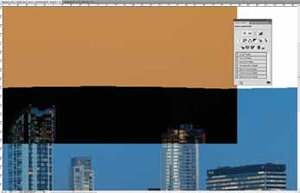articles/Printing/gold-page2
Panning for Gold in the Real World - part 2 of 1 2 3 4 5
by Mike McNamee Published 01/04/2013

When you make a manual assembly of layers in Photoshop it helps to change the Layer Blending Mode temporarily to 'Difference' so you can move the layers into alignment - when the image turns black all pixels are aligned and you can change the mode back to normal.
In daylight, even, we shot too many frames on the upper, cloud row making 11 frames instead of the required 10 (more about speed later). For this reason we decided to shoot with the camera in the landscape plane at 175mm. The disposition of the frames are annotated on the small-scale image. This nominally 12° field of view matches the smallest 'notch' on our Manfrotto VR head at 10°. Experience has taught us that the best time to shoot a dusk panorama on the river is between 0 and 25 minutes past the time of the sunset. At this moment the sky turns an intense blue, but the problem is that the light is fading very rapidly - hence the need for speed.

Hugin and Pannini General did a great job in a tight kichen for this 180° field of view. Note the straight lines in the cupboards although the range has bellied out a little.
Our workflow is to level up the apparatus some 30 minutes before the appointed time and make a few test shots. Then, when the 20 minute mark is reached we shoot (all manually) without even looking through the view finder. Our meta data shows that it was taking 36s to make each row followed by about 20seconds to change the horizon angle. We shot the base as the second row and finally the upper sky row to give us the 18 frames. The upper row was 0.35 stops too dark showing just how fast the light was changing. Other important kit for the workflow are an electronic cable release, hat, gloves and a head torch (so you can smoothly release the shutter, stay warm and see what you are doing respectively).
Please Note:
There is more than one page for this Article.
You are currently on page 2
- Panning for Gold in the Real World page 1
- Panning for Gold in the Real World page 2
- Panning for Gold in the Real World page 3
- Panning for Gold in the Real World page 4
- Panning for Gold in the Real World page 5
1st Published 01/04/2013
last update 09/12/2022 14:54:48
More Printing Articles
There are 16 days to get ready for The Society of Photographers Convention and Trade Show at The Novotel London West, Hammersmith ...
which starts on Wednesday 14th January 2026





